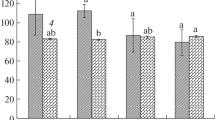Abstract
The spectral control of hypocotyl elongation in light-grown Chenopodium rubrum L. seedlings has been studied. The results showed that although the seedlings responded to changes in the quantity of combined red and far-red radiation, they were also very sensitive to changes in the quantity of blue radiation reaching the plant. Altering the proportion of red: far-red radiation in broad waveband white light caused marked differences in hypocotyl extension. Comparison of the responses of green and chlorophyll-free seedlings indicated no qualitative difference in the response to any of the light sources used, although photosynthetically incompetent plants were more sensitive to all wavelengths. Blue light was found to act primarily of a photoreceptor which is different from phytochrome. It is concluded that hypocotyl extension rate in vegetation shade is photoregulated by the quantity of blue light and the proportion of red: far-red radiation. In neutral shade, such as that caused by stones or overlying soil, hypocotyl extension appears to be regulated primarily by the quantity of light in the blue waveband and secondarily by the quantity of light in the red and far-red wavebands.
Similar content being viewed by others
Abbreviations
- B:
-
blue
- FR:
-
far-red
- k 1, k 2 :
-
rate constants for photoconverison of Pr to Pfr and Pfr to Pr, respective
- k 1/k 1 +k 2=ϕ:
-
phytochrome photoequilibrium
- k 1 +k 2=Θ:
-
phytochrome cycling rate
- Pr=R:
-
absorbing form of phytochrome
- Pfr=FR:
-
absorbing form of phytochrome
- Ptot :
-
Pr+Pfr
- PAR:
-
photosynthetically active radiation = 400–700 nm
- R:
-
red
- WL:
-
white light
References
Bartels, P.G., Hyde, A. (1970) Chloroplast development in 4-chloro-5-(dimethylamino)-2-(α, α, α-trifluoro-m-tolyl)-3(2H) pyridazinone (Sandoz 6708)-treated wheat seedlings. Plant Physiol. 45, 807–810
Beggs, C.J., Holmes, M.G., Jabben, M., Schäfer, E. (1980) Action spectra for the inhibition of hypocotyl growth by continuous irradiation in light- and dark-grown Sinapis alba L. seedlings. Plant Physiol. 66, 615–618
Beggs, C.J., Geile, W., Holmes, M.G., Jabben, M., Jose, M., Schäfer, E. (1981) High irradiance response promotion of a subsequent light induction response in Sinapis alba L. Planta 151, 135–140
Hoagland, D.R., Arnon, D.I. (1939) The water culture method for growing plants without soil. Calif. Agric. Exp. Stn. Cir. 327, 1–39
Holmes, M.G., Beggs, C.J., Jabben, M., Schäfer, E. (1981) Hypocotyl growth in Sinapis alba L.: The roles of light quality and quantity Plant, Cell Environ. 4, (in press)
Holmes, M.G., Smith, H. (1977) The function of phytochrome in the natural environment II. The influence of vegetation canopies on the spectral energy distribution of natural daylight. Photochem. Photobiol. 25, 539–545
Holmes, M.G., Wagner, E. (1981) Phytochrome control of hypocotyl extension in light-grown Chenopodium rubrum L. Physiol. Plant. (in press)
Jabben, M., Deitzer, G.F. (1979) Effects of the herbicide SAN 9789 on photomorphogenic responses. Plant Physiol. 63, 481–485
McLaren, J.S., Smith, H. (1978) Phytochrome control of the growth and development of Rumex obtusifolius under simulated canopy light environment. Plant, Cell Environ. 1, 61–67
Mohr, H. (1972) Lectures on photomorphogenesis. Springer, Berlin Heidelberg New York
Smith, H. (1975) Phytochrome and photomorphogenesis. McGraw-Hill, Maidenhead
Smith, H. (1980) The role of phytochrome in the natural environment. In: Proc. Int. Congress Photobiology, Strasbourg
Smith, H., Holmes, M.G. (1977) The function of phytochrome in the natural environment. III. Measurement and calculation of phytochrome photoequilibria. Photochem. Photobiol. 25, 547–550
Author information
Authors and Affiliations
Rights and permissions
About this article
Cite this article
Ritter, A., Wagner, E. & Holmes, M.G. Light quantity and quality interactions in the control of elongation growth in light-grown Chenopodium rubrum L. seedlings. Planta 153, 556–560 (1981). https://doi.org/10.1007/BF00385541
Received:
Accepted:
Issue Date:
DOI: https://doi.org/10.1007/BF00385541




